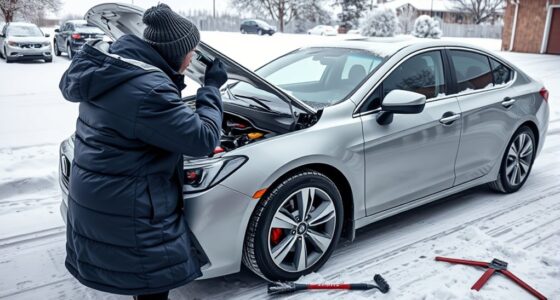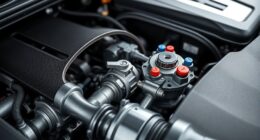After winter, it’s essential to perform spring maintenance on your car to guarantee safety and performance. Check and rotate your tires to promote even wear and maintain grip. Inspect for damage and adjust tire pressure for ideal fuel efficiency. Also, examine fluids like oil, antifreeze, and brake fluid, replacing or topping them off as needed. Addressing these areas helps prevent costly repairs and prepares your vehicle for the warmer months. Keep going to learn more tips for a smooth recovery.
Key Takeaways
- Perform tire rotation and inspection to ensure even wear and maintain safety on icy or snowy roads.
- Check and adjust tire pressure to improve fuel efficiency and vehicle handling after winter.
- Inspect and top off fluids like oil, antifreeze, brake fluid, and windshield washer to prevent freezing and ensure proper function.
- Look for winter damage such as cracks, punctures, or worn components that may need repair or replacement.
- Conduct a comprehensive vehicle check to address winter wear and prepare your car for spring driving conditions.

Are you ready to give your home a fresh start after winter? It’s the perfect time to turn your attention to your car and perform some essential spring maintenance. After months of cold weather, snow, and icy roads, your vehicle needs a bit of TLC to keep it running smoothly and safely. Starting with basic checks can prevent bigger issues down the road and guarantee your car’s longevity. Two critical steps in your post-winter routine are tire rotation and fluid checks. These simple tasks can greatly improve your vehicle’s performance, safety, and fuel efficiency.
Spring car maintenance is essential after winter’s wear—focus on tire rotation and fluid checks to ensure safety and performance.
Tire rotation is often overlooked but is indispensable after winter’s harsh conditions. Cold temperatures, snow, and ice put extra stress on your tires, causing uneven wear and tear. By rotating your tires, you promote even treadwear, which extends tire life and maintains ideal grip on the road. It’s best to follow your vehicle manufacturer’s recommended rotation schedule, often every 5,000 to 8,000 miles, but especially after winter, it’s wise to have them checked. When you perform a tire rotation, you also get the chance to inspect your tires for damage, such as cuts or punctures, which might have occurred during icy driving. Properly inflated tires are essential for safe driving and fuel efficiency, so take this opportunity to check the pressure and adjust it to the recommended levels.
Fluid checks are equally important after winter. Cold weather can cause fluids like oil, antifreeze, brake fluid, and windshield washer fluid to thin out or become contaminated. Old or low fluids can impair your car’s performance and lead to costly repairs if left unchecked. Start by inspecting the oil; if it looks dark or gritty, it’s time for an oil change. Next, check your antifreeze to ensure it’s at the right level and mix ratio, preventing your engine from freezing or overheating during temperature fluctuations. Brake fluid should be clear and at the proper level—any discoloration indicates the need for a flush or replacement. Don’t forget to top off your windshield washer fluid, especially since winter grime and salt can clog your wipers and reduce visibility. Using the right fluids and maintaining proper levels help your vehicle run smoothly and extend the life of critical components.
Spring is the perfect time to give your car a thorough checkup. By focusing on tire rotation and fluid checks, you’re addressing two of the most essential aspects of vehicle maintenance. These steps help you spot potential problems early, improve safety, and guarantee your car is ready for the adventures ahead. Taking a little time now saves you money later and keeps you confidently on the road all season long.
Frequently Asked Questions
How Often Should I Check My Tire Pressure After Winter?
You should check your tire pressure at least once a month and after any significant temperature changes. Regular seasonal tire checks help maintain ideal pressure, improving safety and fuel efficiency. Use tire pressure tips like using a reliable gauge and inspecting for leaks. During spring, especially after winter, it’s essential to ensure your tires are properly inflated to prevent uneven wear and potential blowouts. Stay proactive with these checks for a smoother ride.
Can I Perform Spring Car Maintenance Myself?
Yes, you can perform spring car maintenance yourself. Start with DIY inspections like checking tire pressure, inspecting belts, and fluid levels. Follow a seasonal checklist to guarantee your vehicle’s ready for warmer months. Basic tasks such as changing windshield wipers or topping off fluids are manageable with some guidance. Regular maintenance boosts safety and prolongs your car’s life, saving you money and giving you peace of mind.
When Is the Best Time to Replace Windshield Wipers?
Did you know that most drivers wait over a year to replace their windshield wipers, risking impaired visibility? The best time for windshield replacement is before heavy spring storms arrive, so you should inspect your wiper blades now. During a wiper blade inspection, check for cracks, tears, or stiffness. If they streak or don’t clear the glass effectively, it’s time for new windshield wipers to stay safe on the road.
Are There Specific Fluids I Should Change During Spring?
You should consider fluid replacement during spring to guarantee your car runs smoothly. Focus on changing fluid types like engine oil, coolant, and windshield washer fluid, as winter can cause them to degrade or become contaminated. Fresh fluids help prevent corrosion, improve cooling, and ensure visibility. Check your owner’s manual for recommended intervals, but generally, spring is the perfect time to replace these fluids and keep your vehicle performing at its best.
How Do I Identify Early Signs of Rust Damage?
Spot signs of rust swiftly by conducting careful corrosion prevention checks. Look for bubbling paint, flaky flakes, or discoloration on your vehicle’s surface, especially in hidden areas like wheel wells, undercarriage, and door sills. Rust inspection reveals subtle surface changes that signal trouble. Catching corrosion early guarantees you can combat corrosion proactively, preventing widespread damage and costly repairs. Regular visual vigilance keeps your car’s integrity intact and rust-free.
Conclusion
As you gently tune up your car for spring, you’re giving it a well-deserved refresh, helping it regain its vibrancy after winter’s wear. A little care now makes certain it stays in top shape and keeps unexpected surprises at bay. Think of it as a friendly nudge to your vehicle, inviting it to perform at its best without fuss. With this mindful approach, you’ll enjoy the season’s journeys, confident that your car’s ready to blossom along every mile.








